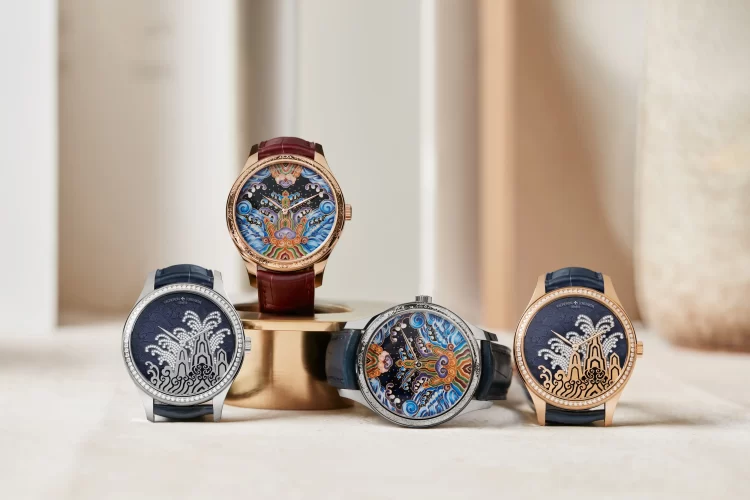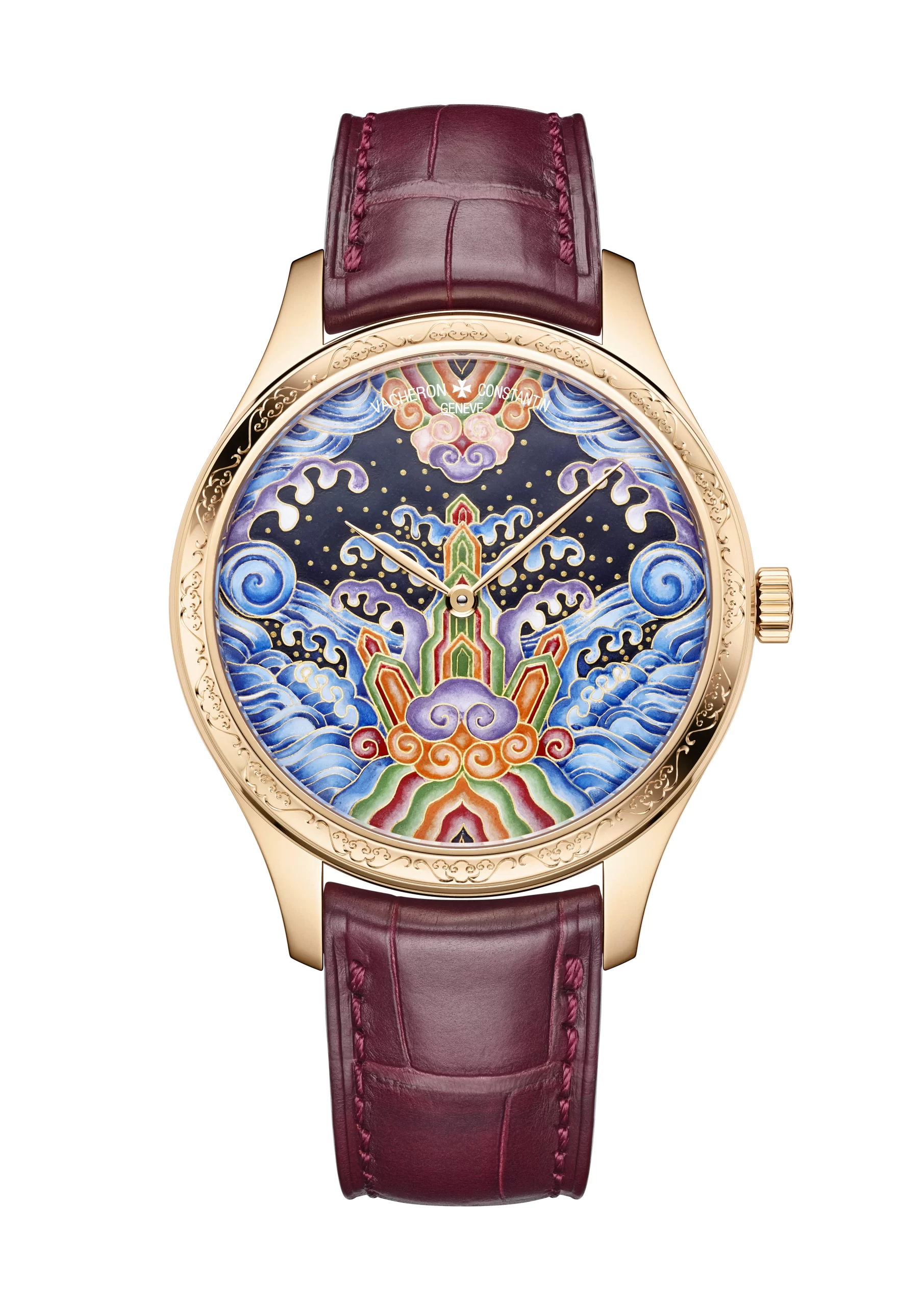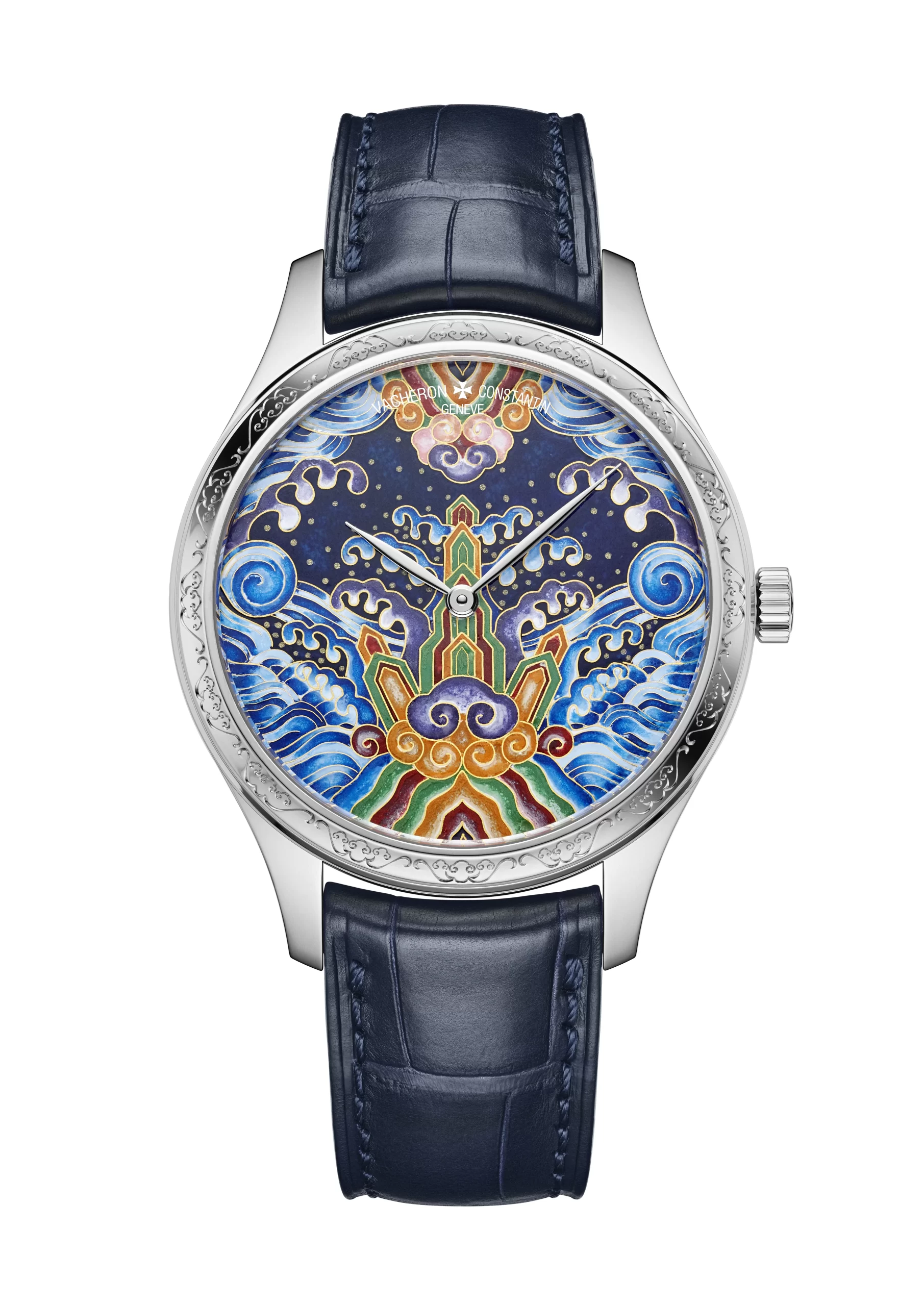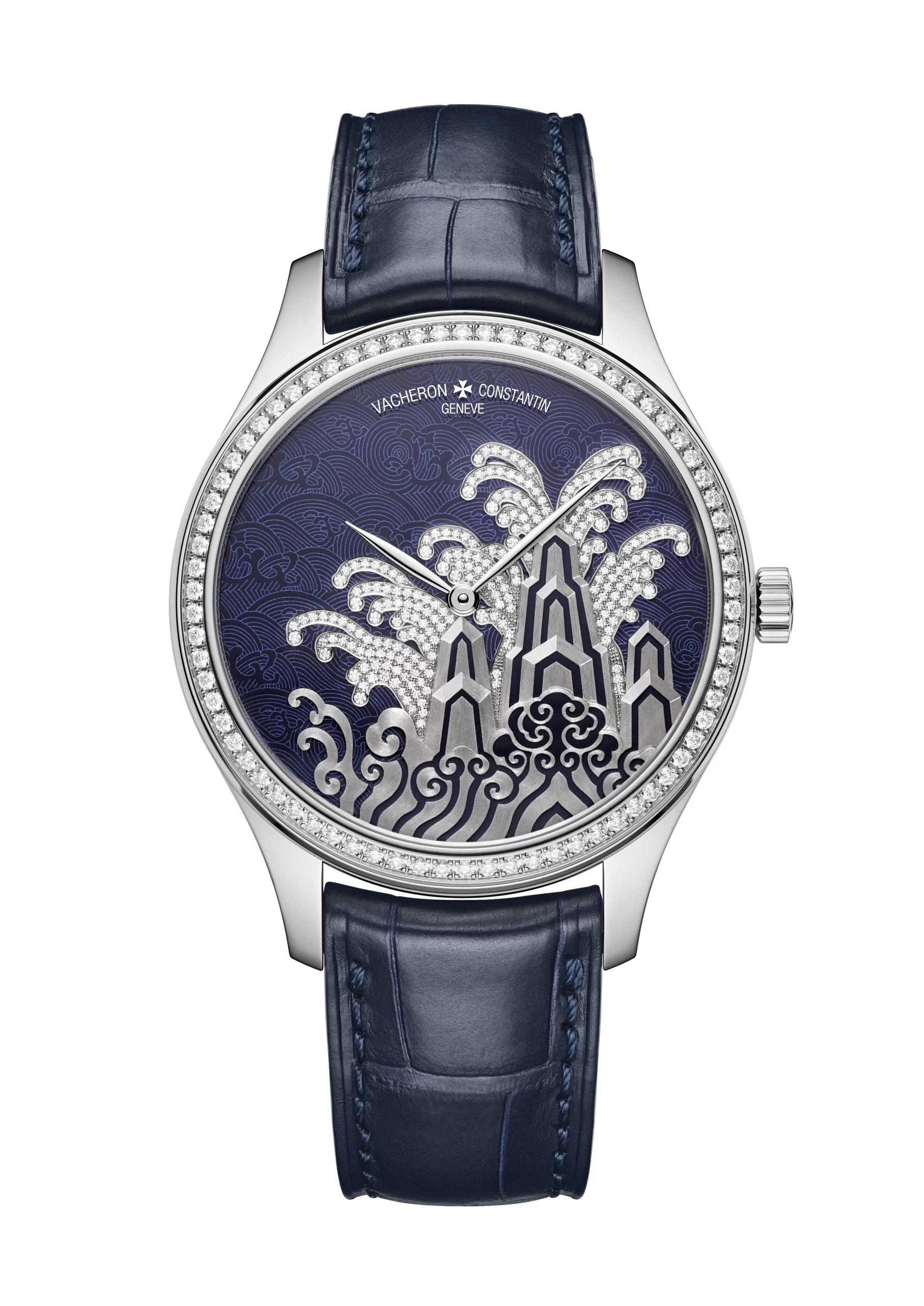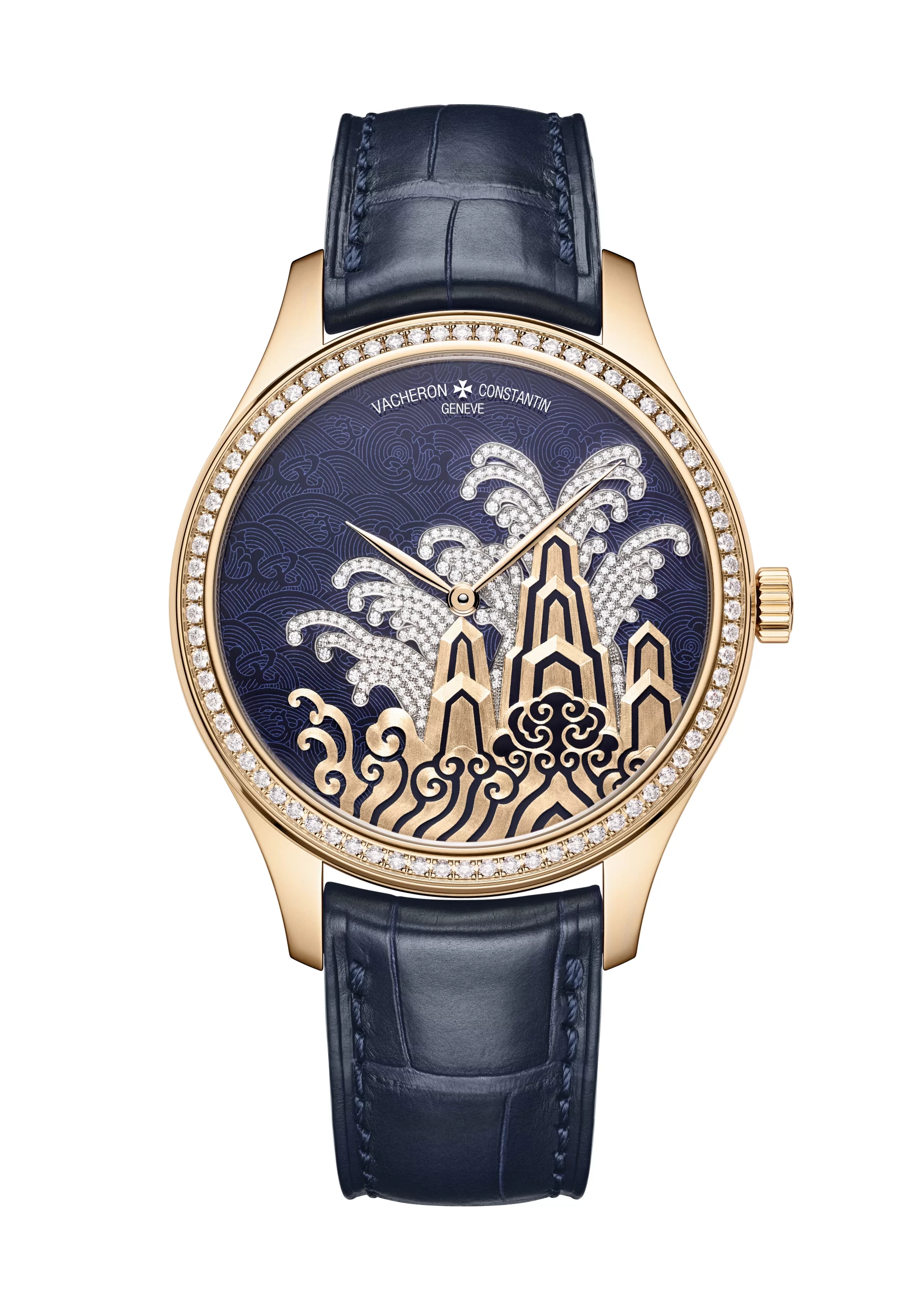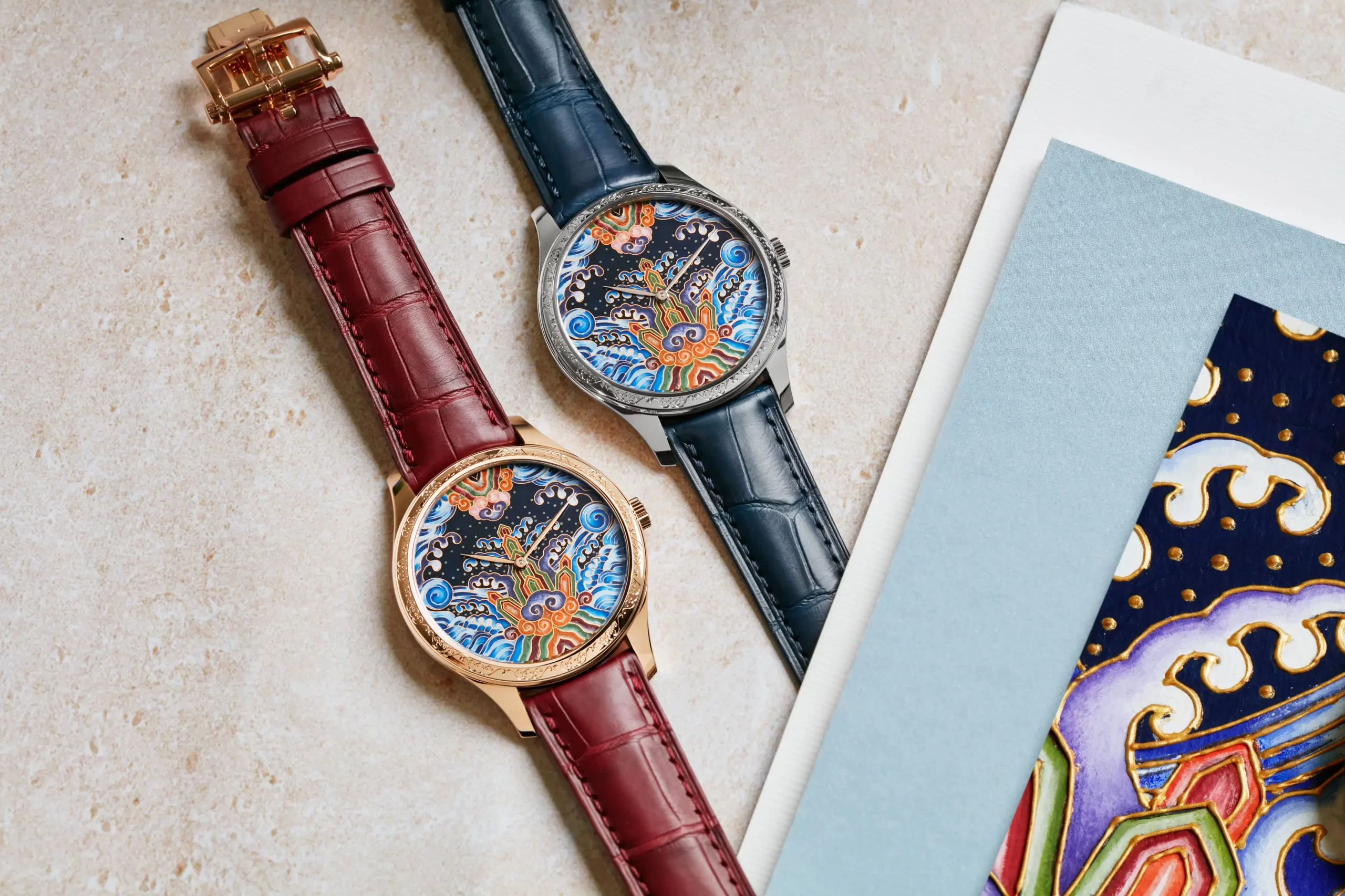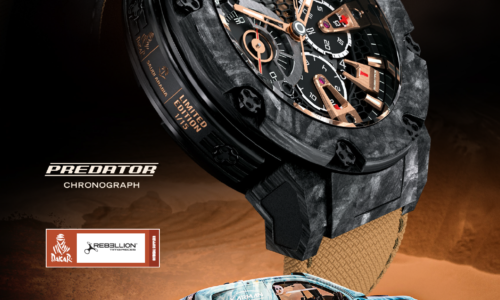Métiers d’Art: Tribute to traditional symbols
Vacheron Constantin pays tribute to ancient Chinese culture with its new Métiers d’Art – Tribute to traditional symbols series, featuring two
interpretations of the “Seawater Cliff”, a legendary Chinese motif that first appeared in the 14th century. This depiction of wave-lashed cliffs belongs to the cultural tradition of Imperial China, a special field of study for Mr. Song, the Former Associate Research Librarian of the Palace Museum, who guided the Vacheron Constantin artisans on this project. Housed in a 38 mm- diameter case in 18K pink or white gold, powered by Calibre 2460 driving central hours and minutes hands, these dials provide a forceful, beautiful expression of Chinese cultural symbolism.
- A series of four limited-edition watches, created in close collaboration with the Former Associate Research Librarian of Palace
Museum housed in Beijing’s Forbidden City. - A cultural tribute with the representation of the “Seawater Cliff” motif, a decorative symbol specific to the imperial court of the Ming
and Qing dynasties. - The creative expression of the Maison’s profound attachment to the world of artistic crafts and culture through its master artisans.
A fruitful cultural collaboration
The Métiers d’Art – Tribute to traditional symbols series offers a journey into the history and culture of China’s last two Imperial dynasties, from the 14th to the early 20th centuries. To immerse itself in the distinctive decor of this period, the Maison took a particular interest in the decorative arts and notably in the “Seawater Cliff” motif omnipresent on courtly architectural elements, but also on furniture and porcelain, as well as on imperial clothing and particularly the so-called ‘dragon’ robes. These richly embroidered silk ceremonial garments conveyed distinctive symbolism according to their motifs.
For this research work, the Maison benefited from the advice of Mr. Song, the Former Associate Research Librarian of Palace Museum housed in Beijing’s Forbidden City.
In agreement with this expert in Chinese history and symbolism, studies on the dials of the four Métiers d’Art limited editions focused on the “Seawater Cliff” motif. Extensively documented by Mr. Song, this depiction features a mountain towering above the tides with their ebb and flow lashing its cliffs. Embroidered on the lower hem and cuffs of the robe, this ornamentation was regarded as auspicious for those who wore it.
A cultural tribute
Although water and mountains inspired the decoration of various artefacts in China as early as the Neolithic period – and were represented in an increasingly figurative way throughout the first millennium AD – the combination of the two came later. It was with the Ming (1368-1644) and Qing (1644-1911) dynasties that the motif really took shape. Officially named “Seawater Cliff” under Emperor Wanli (1573-1620), it was reserved for the Imperial family. As its name suggests, this motif refers to the sea, its tides represented by long undulating lines that come crashing down in powerful surges against the cliff.
Symbolising the emperor’s immutability faced with the vagaries of life, these overhanging mountain cliffs are unaffected by the waves.
In Chinese, the words ‘tide’ and ‘dynasty’ are homonyms, while the word ‘cliff’ can also mean ‘ginger buds’ – of which one can recognise the outline on the edge of this escarpment overlooking the sea. In Chinese tradition, water and mountains are also strong territorial symbols. With this “Seawater Cliff” motif richly emblazoned on his ceremonial robes the emperor embodied stability. Like the unshakeable cliff above the waves, a symbol of peace and longevity, he was the guarantor of the country’s fortune and prosperity. This motif became very popular and spread across all social classes in furniture, sculpture, decorative objects and architecture.
An ode to craftsmanship
Beating at the heart of the 38 mm-diameter case in 18K pink and white gold is in-house Calibre 2460, chosen for its aesthetic appeal and compact dimensions (26.2 mm in diameter and 3.60 mm thick). The movement’s configuration driving central hands ensures seamless integration with the dial to give scope and depth to the passing hours and minutes. Endowed with a 40-hour power reserve, it meets all the criteria of the Hallmark of Geneva certifying both origin and horological expertise. The 22K gold rotor echoes the symbolism of the dial, since the oscillating weight is delicately engraved with a motif recalling the movement of waves and tides.
Métiers d’Art – Tribute to traditional symbols – Eternal flow: cloisonné enamelling and engraving
Against a star-studded night sky, the mountain peaks, bordered by vegetation in the shape of ginger buds, are caressed by tidal waves. With its colourful aesthetic and respect for traditional Chinese ornamentation, this depiction is a masterpiece of cloisonné enamelling, which was originated in China. The technique is also named Jingtai Blue , which pays tribute to its heyday which is in the era of Emperor Jingtai in the Ming Dynasty. The latter technique was a natural choice because of the flexibility it offers in terms of both the choice of colours and the graphic design of the intricate shapes.
Laying the 220 gold wires used to delineate the enamelling fields forming the “Seawater Cliff” motif along requires more than 50 hours of work to shape the motif. This is followed by the enamelling itself in successive layers according to colour and intensity, with a kiln firing between each operation. It takes no less than 70 hours to achieve the rich tones that are so characteristic of this piece. A final polish then completes the work to highlight the gold cloisonné that gives substance to the motif. Finally, a translucent enamel coating instils a unique glow into this highly architectural composition, enhanced by the finesse of the lines and ancestral expertise.
To highlight this enamelling work, the bezel of the model is entirely hand-engraved with a bat motif. In Chinese, ‘bat’ and ‘happiness’ have similar pronunciations – which goes some way to explaining the status of this animal as a harbinger of good fortune. In Chinese decoration, five bats are often seen together, traditionally expressing the “Five Good Fortunes”: longevity, wealth, stability, virtue and happiness. On this watch, the engraver has depicted the bat in the form of a frieze composed of successive volutes representing the animal’s characteristic silhouette.
Métiers d’Art – Tribute to traditional symbols – Moonlight slivers: Grand Feu enameling, engraving and gemsetting
For this second “Seawater Cliff” motif, the aim was to achieve a depth effect on a monochrome base. Crafted in 18K white or pink gold depending on the model, the all-in-one-piece dial features hollowed waves, blue enamelled parts and raised diamond-set sections for the mountain area. The master artisan has used a blend of techniques to create this composition, endowing the motif with a subtle yet distinctive aesthetic.
The gold dial is divided into three parts. The first, which delineates the sea, is made of deep-blue Grand Feu enamel applied in successive kiln-fired layers. This is followed by patient engraving. The technique used for this depiction of waves is engraving on enamel to create volutes. These are then accentuated by the master artisan, who fills in the furrows with white enamel that is then also fired. This extremely thin layer creates a subtle shadow on a delicately textured background, creating the impression of a sea in motion.
The second part, devoted to the sea tides running along the mountain range, is reserved for the setting. Each sea tide is delicately hand-set with brilliant-cut diamonds, evoking the moon slivers that inspired the name of this piece. Meanwhile, the third part of the dial serves to add relief, with a mountain range lashed by foaming waves. Meticulously engraved with tone-on-tone champlevé enamel inlays to accentuate the depth of the landscape, this portrayal of the mountains is also worked in drypoint to accentuate the perspective effect.
The sparkling brilliant-cut diamonds adorning the sea tides exude an ashen moonlight gleam, echoed by the setting of the bezel entirely adorned with brilliant-cut diamonds.
Interview with Christian Selmoni, Style & Heritage Director
How did you come up with the “Seawater Cliff” motif?
The Vacheron Constantin design department wanted to explore traditional Chinese symbolism for this new Métiers d’Art series. The aim was to complement the existing offer often found on watch dials celebrating Chinese New Year. In the course of this research, it became clear that the decoration of ancient imperial palaces and the court’s ceremonial robes offered some interesting avenues to explore, as confirmed by the contacts established with Mr. Song. This former researcher and scholar at the Palace Museum in Beijing is a specialist in Chinese symbolism. He visited the Manufacture Vacheron Constantin in Geneva to provide the Maison’s teams with valuable input. It was during these exchanges that the “Seawater Cliff” motif came to the fore. Mr. Song provided the necessary documentation and sound advice for the Maison to interpret this motif in two different ways. While each has its own character, they both share a common symbolism.
What determined the choice of artistic crafts?
The “Seawater Cliff” motif, as seen in Imperial architecture and ceremonial robes, is graphically very strong and richly coloured. This motif features a composition of sinuous lines for the tides, interwoven volutes for the waves lashing the cliffs and vertical structures for the mountain range above. This meant calling upon techniques capable of transcribing both the vast chromatic palette of this decoration and all its complexity. For the first Métiers d’Art – Tribute to traditional symbols – Eternal flow timepiece, the cloisonné enamel technique, which originated in China, was the natural choice due to the flexibility it affords in the choice of colours and the graphic creation of highly elaborate shapes. For the dial of the Métiers d’Art – Tribute to traditional symbols – Moonlight slivers watch, the aim was to achieve a depth effect on a monochrome base. Engraving is the only way to achieve this kind of result, with recessed enamelled and gemset parts and others in relief to accentuate the 3D effect, which is achieved here using a ‘flat wash’ uniform layer of paint in a single colour.
Vacheron Constantin’s Métiers d’Art series often draw inspiration from history and ancient civilisations, as is the case with this new series. Is there any particular reason behind this?
As Vacheron Constantin explains, these Métiers d’Art series celebrate decorative techniques applied to watchmaking and jewellery, while inspired by art, history and culture. The interesting thing about history is that ancient civilisations reached an extreme level of sophistication in decorative techniques. Often, some of these techniques have even gradually vanished with the industrialisation and digitalisation of our societies. It’s up to a Maison like Vacheron Constantin, which is strongly committed to preserving artistic craftsmanship, to highlight these techniques by drawing inspiration from the most accomplished creations in this field. In the case of this Tribute to traditional symbols series, the main focus was on embroidery work. By reproducing these ancient motifs on a watch dial, the Maison’s teams and artisans are obliged to demonstrate creativity in order to preserve the spirit of the motifs, while at the same time shining a spotlight on these incredibly rich Imperial garments, symbols of a key period in Chinese history.
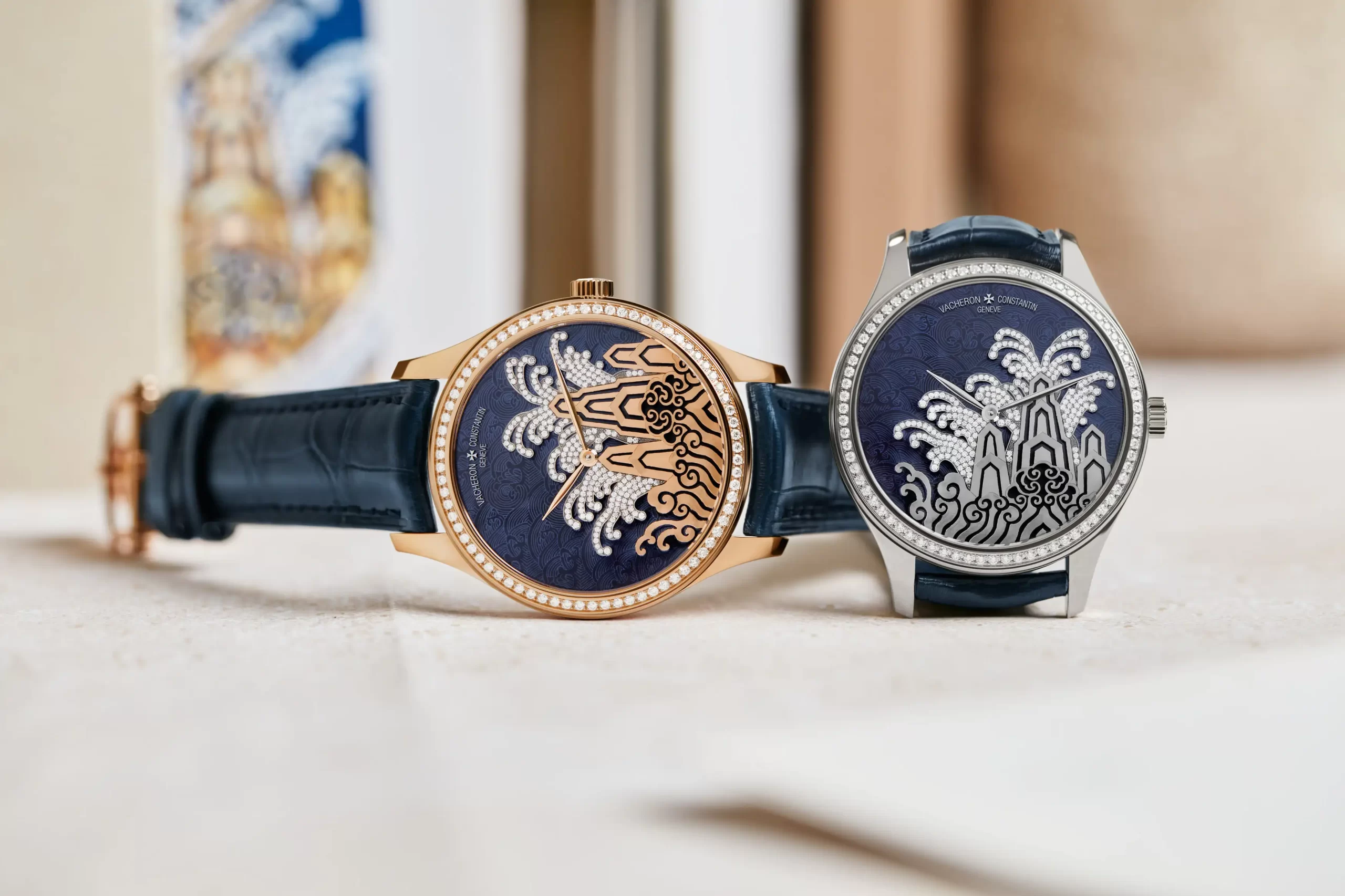
Métiers d’Art – Tribute to traditional symbols – Eternal flow
References 2400A/000R-H024, 2400A/000G-H023
Calibre 2460
Manufacture calibre
Mechanical, self-winding
26.2 mm (11 ¼’’’) diameter, 3.6 mm thick
Approx. 40 hours of power reserve
4 Hz (28,800 vibrations/hour)
182 components
27 jewels
Indications Hours, minutes
Case 18K 5N pink gold
18K white gold
38 mm diameter, 9.88 mm thick
Hand-engraved bezel
Transparent sapphire crystal caseback
Water-resistance tested at a pressure of 3 bar (approx. 30 metres)
Dial 18K 5N pink gold
18K white gold
Cloisonné enamel
Straps/Buckles Delivered with burgundy or dark blue alligator leather strap with stitches of the
same colour
Alligator leather lining
Each strap is equipped with an 18K 5N pink gold/18K white gold folding clasp
Limited Edition of 15 pieces each.
Métiers d’Art – Tribute to traditional symbols – Moonlight slivers
Reference 2405A/000R-H022, 2405A/000G-H021
Calibre 2460
Manufacture calibre
Mechanical, self-winding
26.2 mm (11 ¼’’’) diameter, 3.6 mm thick
Approx. 40 hours of power reserve
4 Hz (28,800 vibrations/hour)
182 components
27 jewels
Indications Hours, minutes
Case 18K 5N pink gold
18K white gold
38 mm diameter, 9.88 mm thick
Diamond-set bezel with 74 brilliant-cut diamonds
Transparent sapphire crystal caseback
Water-resistance tested at a pressure of 3 bar (approx. 30 metres)
Dial 18K 5N pink gold
18K white gold
Grand Feu enamel
18K gold hand-engraved motif
Diamond-setting with 239 brilliant-cut diamonds
Straps/Buckles Delivered with dark blue alligator leather strap with stitches of the same colour
Alligator leather lining
Each strap is equipped with an 18K 5N pink gold/18K white gold folding clasp
Total diamond-setting 313 diamonds, totalling approx. 0.9 carats (guaranteed minimum carats)
Limited Edition of 15 pieces each.
#VacheronConstantin
#OneOfNotMany
